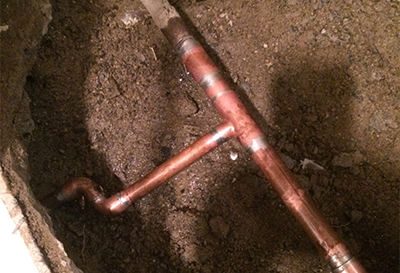The article author is making a few good annotation about Leaking water lines as a whole in this content following next.

Early detection of dripping water lines can minimize a possible disaster. Some small water leaks may not be noticeable.
1. Take A Look At the Water Meter
Every home has a water meter. Inspecting it is a proven way that helps you uncover leaks. For beginners, shut off all the water resources. Make sure nobody will flush, utilize the faucet, shower, run the washing device or dish washer. From there, go to the meter and also watch if it will certainly alter. Considering that no person is using it, there ought to be no motions. If it relocates, that suggests a fast-moving leak. If you detect no changes, wait an hour or 2 as well as inspect back once again. This suggests you might have a slow leak that could even be below ground.
2. Check Water Usage
If you spot unexpected changes, regardless of your usage being the very same, it implies that you have leakages in your plumbing system. An unexpected spike in your costs suggests a fast-moving leakage.
On the other hand, a steady rise on a monthly basis, despite the very same practices, reveals you have a slow leakage that's additionally slowly rising. Call a plumber to extensively check your property, particularly if you really feel a cozy area on your floor with piping beneath.
3. Do a Food Coloring Test
When it comes to water intake, 30% comes from toilets. If the color somehow infiltrates your bowl during that time without flushing, there's a leak between the tank and bowl.
4. Asses Exterior Lines
Don't forget to examine your exterior water lines also. Examination faucets by affixing a yard pipe. Needs to water permeate out of the link, you have a loosened rubber gasket. Replace this as well as make sure all connections are limited. If you have actually obtained an automatic sprinkler, it will certainly aid get it properly checked out and also kept every year. One little leakage can waste tons of water and spike your water bill.
5. Evaluate and Evaluate the Circumstance
Homeowners ought to make it a habit to examine under the sink counters and also also inside closets for any bad odor or mold and mildew development. These two red flags suggest a leakage so prompt attention is required. Doing regular evaluations, also bi-annually, can save you from a significant problem.
Check for stainings and compromising as a lot of pipelines and also appliances have a life expectations. If you believe leaking water lines in your plumbing system, don't wait for it to intensify.
Early discovery of dripping water lines can alleviate a possible calamity. Some little water leaks may not be visible. Checking it is a guaranteed method that assists you find leakages. One small leakage can lose bunches of water and also spike your water costs.
If you believe dripping water lines in your plumbing system, do not wait for it to rise.
WARNING SIGNS OF WATER LEAKAGE BEHIND THE WALL
PERSISTENT MUSTY ODORS
As water slowly drips from a leaky pipe inside the wall, flooring and sheetrock stay damp and develop an odor similar to wet cardboard. It generates a musty smell that can help you find hidden leaks.
MOLD IN UNUSUAL AREAS
Mold usually grows in wet areas like kitchens, baths and laundry rooms. If you spot the stuff on walls or baseboards in other rooms of the house, it’s a good indicator of undetected water leaks.
STAINS THAT GROW
When mold thrives around a leaky pipe, it sometimes takes hold on the inside surface of the affected wall. A growing stain on otherwise clean sheetrock is often your sign of a hidden plumbing problem.
PEELING OR BUBBLING WALLPAPER / PAINT
This clue is easy to miss in rooms that don’t get much use. When you see wallpaper separating along seams or paint bubbling or flaking off the wall, blame sheetrock that stays wet because of an undetected leak.
BUCKLED CEILINGS AND STAINED FLOORS
If ceilings or floors in bathrooms, kitchens or laundry areas develop structural problems, don’t rule out constant damp inside the walls. Wet sheetrock can affect adjacent framing, flooring and ceilings.
https://www.servicemasterbyzaba.com/blog/how-to-detect-water-leakage-in-walls/

As a keen reader on Locating water leaks, I imagined sharing that piece of content was smart. For those who appreciated our page plz do not forget to pass it around. Bless you for your time. Kindly pay a visit to our site back soon.